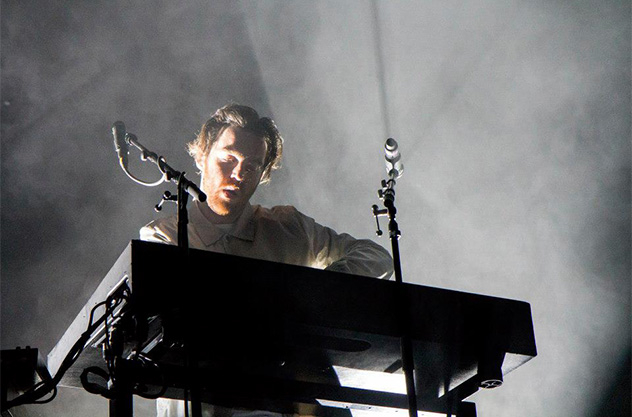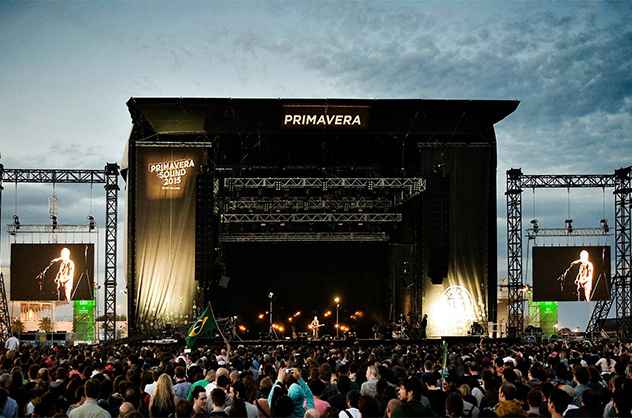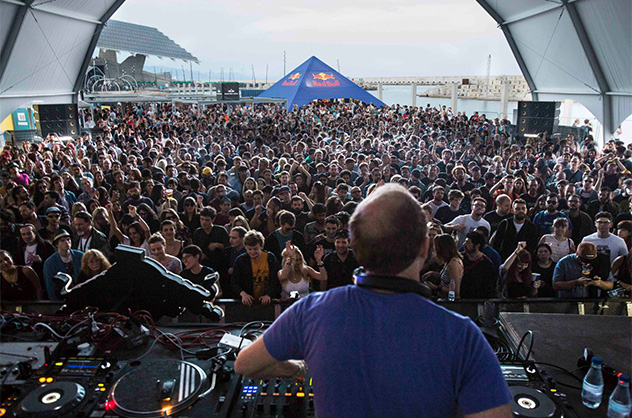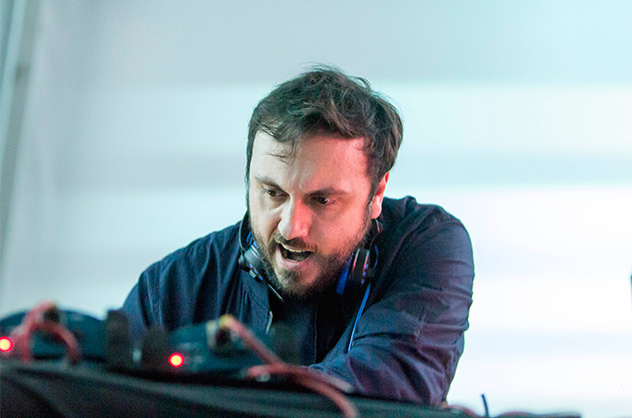- Most people see Primavera Sound as a festival for a better quality of guitar band, and rightly so. However, in recent years much has been done to entice electronic music fans to the three-day event in Barcelona, and development in that area was again evident this year. Until 2012, Primavera Sound had no dedicated electronic stage at all. That year it introduced a small Boiler Room area, and by last year that had morphed into the Bowers & Wilkins Sound System, a fully-fledged, medium-sized tent. For 2015, the Bowers & Wilkins Sound System graduated to a much higher-capacity semi-enclosed area, with bigger names peppering bills curated by Resident Advisor and RBMA. It has felt like a natural, wise and progressive move for the festival, and has reinvigorated enthusiasm among a sizeable chunk of the event's regular attendees.
Plenty of other things were working in the festival's favour this year, too. Given that we're talking about Barcelona in late May, newcomers are generally surprised to find that Primavera Sound is often a bit chilly—on more than one occasion I've heard shivering punters refer to it as "Invierno Sound" ("invierno" is Spanish for "winter"). That factor was mercifully absent this year, as soaring temperatures and a lack of rain did away with the need for extra layers. The festival's bill also seemed to have taken a slight-but-perceptible turn towards the adventurous compared with recent years, with a more generous smattering of experimental acts like Sunn O))) and Earth among the usual main-stage draws.
 As with last year, most of the action happened in a triangle formed by the Pitchfork Stage, Ray-Ban Stage and Bowers & Wilkins. Congestion in this relatively central area of Parc Del Forum was again eased by situating the two de-facto main stages down by the sea, leaving most attendees with far less commuting time than in previous editions. Bowers & Wilkins kicked off on day one with an engaging set from Roman Flügel (the first of two he would play at the festival that night), and hit its peak several hours later with a packed, peak-time show from Tale Of Us that hit all their usual emotional pressure points.
Polish duo Rebeka turned in perky synth-pop at the small H&M Pro Stage, an area that for some reason consistently drew bizarrely dressed crowds (shout-out to the guy in the historically accurate Viking costume). Chet Faker and his band's set at the Ray-Ban Stage was too glacially paced for their post-midnight slot, while Sunn O)))'s gigantic sheets of noise were exhilarating but inevitably lost some of their intensity in the sprawling outdoor environs of the ATP Stage. Flügel's closing set at Ray-Ban, meanwhile, pivoted on a spectral house sound that was a fitting soundtrack to the Mediterranean sunrise.
As with last year, most of the action happened in a triangle formed by the Pitchfork Stage, Ray-Ban Stage and Bowers & Wilkins. Congestion in this relatively central area of Parc Del Forum was again eased by situating the two de-facto main stages down by the sea, leaving most attendees with far less commuting time than in previous editions. Bowers & Wilkins kicked off on day one with an engaging set from Roman Flügel (the first of two he would play at the festival that night), and hit its peak several hours later with a packed, peak-time show from Tale Of Us that hit all their usual emotional pressure points.
Polish duo Rebeka turned in perky synth-pop at the small H&M Pro Stage, an area that for some reason consistently drew bizarrely dressed crowds (shout-out to the guy in the historically accurate Viking costume). Chet Faker and his band's set at the Ray-Ban Stage was too glacially paced for their post-midnight slot, while Sunn O)))'s gigantic sheets of noise were exhilarating but inevitably lost some of their intensity in the sprawling outdoor environs of the ATP Stage. Flügel's closing set at Ray-Ban, meanwhile, pivoted on a spectral house sound that was a fitting soundtrack to the Mediterranean sunrise.
 Day two's Pitchfork Stage bill was particularly impressive. Shabazz Palaces' slo-mo hip-hop, with its use of mesmeric looping vocals, struck a fine balance between soothing and enlivening after the previous evening's rigours. Primavera staple Ariel Pink's showmanship was a similarly effective tonic, with a lingering version of the beautiful "Picture Me Gone." What we saw of The Juan MacLean's set hit an intoxicating roll from the get-go, with Nancy Whang's star quality and flawless vocals shining as brightly as ever.
A timing clash dragged us off halfway through MacLean's set for Jon Hopkins' live show on the ATP Stage. Hopkins' Kaoss Pad-led performance was as tight as usual, and the quartet of front-of-stage performers with strobe-lit hula-hoops was a canny move on such a big stage. Subdued sound levels, however, hamstrung the moments of glorious abrasiveness that are a key part of the Hopkins live experience, though his finale, a blistering new track that meshed acid with techno and breakbeat, did set pulses racing. Over on the Ray-Ban Stage, Dixon's closing performance was delayed by over half an hour while technicians struggled to overcome sound problems. When it did get going, his vocal-heavy turn didn't have much wrong with it, but the effects of an interminable wait had taken their toll, so I ducked out early to fortify myself for the final day.
Day two's Pitchfork Stage bill was particularly impressive. Shabazz Palaces' slo-mo hip-hop, with its use of mesmeric looping vocals, struck a fine balance between soothing and enlivening after the previous evening's rigours. Primavera staple Ariel Pink's showmanship was a similarly effective tonic, with a lingering version of the beautiful "Picture Me Gone." What we saw of The Juan MacLean's set hit an intoxicating roll from the get-go, with Nancy Whang's star quality and flawless vocals shining as brightly as ever.
A timing clash dragged us off halfway through MacLean's set for Jon Hopkins' live show on the ATP Stage. Hopkins' Kaoss Pad-led performance was as tight as usual, and the quartet of front-of-stage performers with strobe-lit hula-hoops was a canny move on such a big stage. Subdued sound levels, however, hamstrung the moments of glorious abrasiveness that are a key part of the Hopkins live experience, though his finale, a blistering new track that meshed acid with techno and breakbeat, did set pulses racing. Over on the Ray-Ban Stage, Dixon's closing performance was delayed by over half an hour while technicians struggled to overcome sound problems. When it did get going, his vocal-heavy turn didn't have much wrong with it, but the effects of an interminable wait had taken their toll, so I ducked out early to fortify myself for the final day.
 On day three, Blixa Bargeld's growling charisma made Einstürzende Neubauten's set on the ATP Stage an early highlight. That day's Bowers & Wilkins lineup looked particularly strong, with a huge queue gathering at the area's entrance before Daphni's typically joyous and generous opening. John Talabot's special disco set—a repeat of an identically billed show he played in 2014—was, like last year, the standout of the festival. The sheer boggle-eyed elation Talabot is capable of creating with cuts by the likes of Mim Suleiman, Nina Simone and Maurice Fulton isn't something that comes along very often. Crestfallen friends who'd opted instead for The Strokes were informed of their folly, and talk turned to a boycott of Primavera if the John Talabot disco set doesn't become a carved-in-stone tradition.
On day three, Blixa Bargeld's growling charisma made Einstürzende Neubauten's set on the ATP Stage an early highlight. That day's Bowers & Wilkins lineup looked particularly strong, with a huge queue gathering at the area's entrance before Daphni's typically joyous and generous opening. John Talabot's special disco set—a repeat of an identically billed show he played in 2014—was, like last year, the standout of the festival. The sheer boggle-eyed elation Talabot is capable of creating with cuts by the likes of Mim Suleiman, Nina Simone and Maurice Fulton isn't something that comes along very often. Crestfallen friends who'd opted instead for The Strokes were informed of their folly, and talk turned to a boycott of Primavera if the John Talabot disco set doesn't become a carved-in-stone tradition.
 Given the number of electronic artists on show across the weekend, it was surprising to find the last two hours a little thin on talent. Mike Simonetti's airing of DJ Topcat's ghetto-funk classic "I Need Weed In My Life" was very welcome, but I drifted away as his set devolved into humdrum acid. A packed Bowers & Wilkins area was closing with what was billed as the Hivern All-Stars, but when we got there we found a weary atmosphere. An underwhelming last couple of hours notwithstanding, Primavera Sound 2015 had a huge amount going for it, and continues to do an excellent job of becoming a more serious destination for electronic music fans.
Photo credits: Dani Cantó (Lead), Xarlene (Chet Faker, John Talabot), Pere Masramon (Daphni), Eric Pàmies (Stage)
Given the number of electronic artists on show across the weekend, it was surprising to find the last two hours a little thin on talent. Mike Simonetti's airing of DJ Topcat's ghetto-funk classic "I Need Weed In My Life" was very welcome, but I drifted away as his set devolved into humdrum acid. A packed Bowers & Wilkins area was closing with what was billed as the Hivern All-Stars, but when we got there we found a weary atmosphere. An underwhelming last couple of hours notwithstanding, Primavera Sound 2015 had a huge amount going for it, and continues to do an excellent job of becoming a more serious destination for electronic music fans.
Photo credits: Dani Cantó (Lead), Xarlene (Chet Faker, John Talabot), Pere Masramon (Daphni), Eric Pàmies (Stage)
 As with last year, most of the action happened in a triangle formed by the Pitchfork Stage, Ray-Ban Stage and Bowers & Wilkins. Congestion in this relatively central area of Parc Del Forum was again eased by situating the two de-facto main stages down by the sea, leaving most attendees with far less commuting time than in previous editions. Bowers & Wilkins kicked off on day one with an engaging set from Roman Flügel (the first of two he would play at the festival that night), and hit its peak several hours later with a packed, peak-time show from Tale Of Us that hit all their usual emotional pressure points.
Polish duo Rebeka turned in perky synth-pop at the small H&M Pro Stage, an area that for some reason consistently drew bizarrely dressed crowds (shout-out to the guy in the historically accurate Viking costume). Chet Faker and his band's set at the Ray-Ban Stage was too glacially paced for their post-midnight slot, while Sunn O)))'s gigantic sheets of noise were exhilarating but inevitably lost some of their intensity in the sprawling outdoor environs of the ATP Stage. Flügel's closing set at Ray-Ban, meanwhile, pivoted on a spectral house sound that was a fitting soundtrack to the Mediterranean sunrise.
As with last year, most of the action happened in a triangle formed by the Pitchfork Stage, Ray-Ban Stage and Bowers & Wilkins. Congestion in this relatively central area of Parc Del Forum was again eased by situating the two de-facto main stages down by the sea, leaving most attendees with far less commuting time than in previous editions. Bowers & Wilkins kicked off on day one with an engaging set from Roman Flügel (the first of two he would play at the festival that night), and hit its peak several hours later with a packed, peak-time show from Tale Of Us that hit all their usual emotional pressure points.
Polish duo Rebeka turned in perky synth-pop at the small H&M Pro Stage, an area that for some reason consistently drew bizarrely dressed crowds (shout-out to the guy in the historically accurate Viking costume). Chet Faker and his band's set at the Ray-Ban Stage was too glacially paced for their post-midnight slot, while Sunn O)))'s gigantic sheets of noise were exhilarating but inevitably lost some of their intensity in the sprawling outdoor environs of the ATP Stage. Flügel's closing set at Ray-Ban, meanwhile, pivoted on a spectral house sound that was a fitting soundtrack to the Mediterranean sunrise.
 Day two's Pitchfork Stage bill was particularly impressive. Shabazz Palaces' slo-mo hip-hop, with its use of mesmeric looping vocals, struck a fine balance between soothing and enlivening after the previous evening's rigours. Primavera staple Ariel Pink's showmanship was a similarly effective tonic, with a lingering version of the beautiful "Picture Me Gone." What we saw of The Juan MacLean's set hit an intoxicating roll from the get-go, with Nancy Whang's star quality and flawless vocals shining as brightly as ever.
A timing clash dragged us off halfway through MacLean's set for Jon Hopkins' live show on the ATP Stage. Hopkins' Kaoss Pad-led performance was as tight as usual, and the quartet of front-of-stage performers with strobe-lit hula-hoops was a canny move on such a big stage. Subdued sound levels, however, hamstrung the moments of glorious abrasiveness that are a key part of the Hopkins live experience, though his finale, a blistering new track that meshed acid with techno and breakbeat, did set pulses racing. Over on the Ray-Ban Stage, Dixon's closing performance was delayed by over half an hour while technicians struggled to overcome sound problems. When it did get going, his vocal-heavy turn didn't have much wrong with it, but the effects of an interminable wait had taken their toll, so I ducked out early to fortify myself for the final day.
Day two's Pitchfork Stage bill was particularly impressive. Shabazz Palaces' slo-mo hip-hop, with its use of mesmeric looping vocals, struck a fine balance between soothing and enlivening after the previous evening's rigours. Primavera staple Ariel Pink's showmanship was a similarly effective tonic, with a lingering version of the beautiful "Picture Me Gone." What we saw of The Juan MacLean's set hit an intoxicating roll from the get-go, with Nancy Whang's star quality and flawless vocals shining as brightly as ever.
A timing clash dragged us off halfway through MacLean's set for Jon Hopkins' live show on the ATP Stage. Hopkins' Kaoss Pad-led performance was as tight as usual, and the quartet of front-of-stage performers with strobe-lit hula-hoops was a canny move on such a big stage. Subdued sound levels, however, hamstrung the moments of glorious abrasiveness that are a key part of the Hopkins live experience, though his finale, a blistering new track that meshed acid with techno and breakbeat, did set pulses racing. Over on the Ray-Ban Stage, Dixon's closing performance was delayed by over half an hour while technicians struggled to overcome sound problems. When it did get going, his vocal-heavy turn didn't have much wrong with it, but the effects of an interminable wait had taken their toll, so I ducked out early to fortify myself for the final day.
 On day three, Blixa Bargeld's growling charisma made Einstürzende Neubauten's set on the ATP Stage an early highlight. That day's Bowers & Wilkins lineup looked particularly strong, with a huge queue gathering at the area's entrance before Daphni's typically joyous and generous opening. John Talabot's special disco set—a repeat of an identically billed show he played in 2014—was, like last year, the standout of the festival. The sheer boggle-eyed elation Talabot is capable of creating with cuts by the likes of Mim Suleiman, Nina Simone and Maurice Fulton isn't something that comes along very often. Crestfallen friends who'd opted instead for The Strokes were informed of their folly, and talk turned to a boycott of Primavera if the John Talabot disco set doesn't become a carved-in-stone tradition.
On day three, Blixa Bargeld's growling charisma made Einstürzende Neubauten's set on the ATP Stage an early highlight. That day's Bowers & Wilkins lineup looked particularly strong, with a huge queue gathering at the area's entrance before Daphni's typically joyous and generous opening. John Talabot's special disco set—a repeat of an identically billed show he played in 2014—was, like last year, the standout of the festival. The sheer boggle-eyed elation Talabot is capable of creating with cuts by the likes of Mim Suleiman, Nina Simone and Maurice Fulton isn't something that comes along very often. Crestfallen friends who'd opted instead for The Strokes were informed of their folly, and talk turned to a boycott of Primavera if the John Talabot disco set doesn't become a carved-in-stone tradition.
 Given the number of electronic artists on show across the weekend, it was surprising to find the last two hours a little thin on talent. Mike Simonetti's airing of DJ Topcat's ghetto-funk classic "I Need Weed In My Life" was very welcome, but I drifted away as his set devolved into humdrum acid. A packed Bowers & Wilkins area was closing with what was billed as the Hivern All-Stars, but when we got there we found a weary atmosphere. An underwhelming last couple of hours notwithstanding, Primavera Sound 2015 had a huge amount going for it, and continues to do an excellent job of becoming a more serious destination for electronic music fans.
Photo credits: Dani Cantó (Lead), Xarlene (Chet Faker, John Talabot), Pere Masramon (Daphni), Eric Pàmies (Stage)
Given the number of electronic artists on show across the weekend, it was surprising to find the last two hours a little thin on talent. Mike Simonetti's airing of DJ Topcat's ghetto-funk classic "I Need Weed In My Life" was very welcome, but I drifted away as his set devolved into humdrum acid. A packed Bowers & Wilkins area was closing with what was billed as the Hivern All-Stars, but when we got there we found a weary atmosphere. An underwhelming last couple of hours notwithstanding, Primavera Sound 2015 had a huge amount going for it, and continues to do an excellent job of becoming a more serious destination for electronic music fans.
Photo credits: Dani Cantó (Lead), Xarlene (Chet Faker, John Talabot), Pere Masramon (Daphni), Eric Pàmies (Stage)